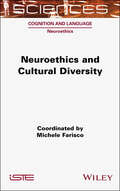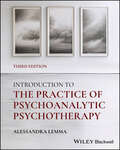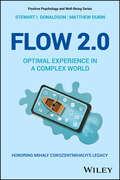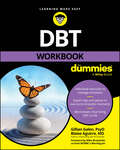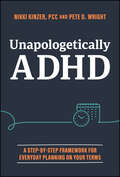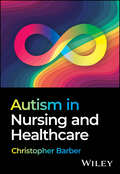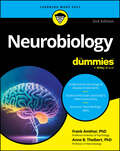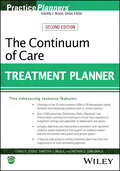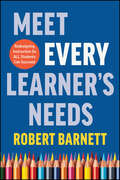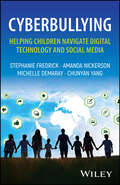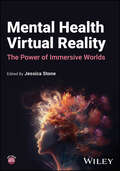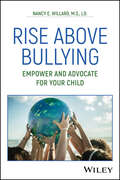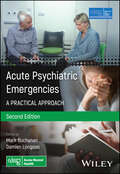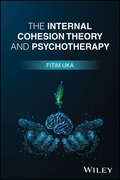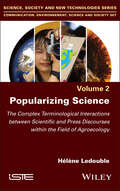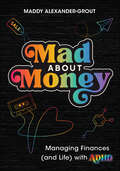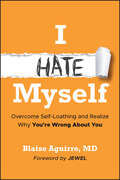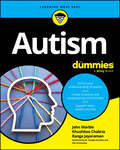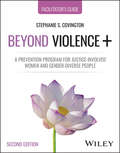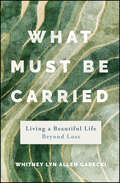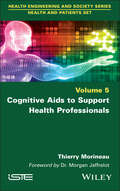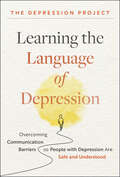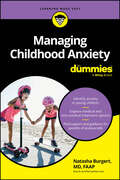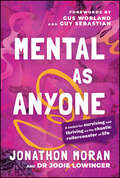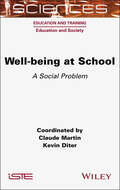- Table View
- List View
Neuroethics and Cultural Diversity
by Michele FariscoThere is a growing discussion concerning the relationship between neuroethical reflections and cultural diversity, which is among the most impactful factors in shaping neuroethics, both as a scientific discipline and a social enterprise. The impacts of culture on science and its public perception are particularly relevant to neuroethics, which aims to facilitate the creation of an interface between neuroscience and society at large. Time is ripe for neuroethics to review the influence of the culturally specific contexts from which it originated (i.e. North America and Western Europe) and to also include other cultural perspectives in the discussion. This book illustrates a convergent approach among different cultures in identifying the main issues raised by neuroscience and emerging technologies. This should be taken as a starting point for advancing in the search for shared solutions, which are, if not definitive, at least sufficiently reliable to be translated into democratic deliberative processes.
Introduction to the Practice of Psychoanalytic Psychotherapy
by Alessandra LemmaAn essential guide to psychoanalytic psychotherapy in modern practice. A must-have for those new to the field and seasoned professionals alike Introduction to the Practice of Psychoanalytic Psychotherapy provides up-to-date, practice-oriented coverage of the latest research and techniques in psychoanalysis. Distinguished clinical psychologist and psychoanalyst Alessandra Lemma synthesizes decades of clinical experience and the latest research into actionable advice for developing analytic skills with clarity, confidence, and adaptability across diverse therapeutic settings. This popular textbook offers step-by-step guidance on essential areas of practice, including conducting assessments, formulating cases, and navigating therapeutic endings. Throughout the book, detailed yet accessible chapters demystify the processes behind psychoanalytic psychotherapy while offering real-world insights into the day-to-day practice of psychoanalytic therapy. Fully revised to reflect contemporary practice, this edition features three entirely new chapters on psychoanalytic ethics, working with the body, and online therapy. Updated and expanded chapters address new developments in Dynamic Interpersonal Therapy (DIT), discuss the current evidence base for psychoanalytic interventions, present new case studies and illustrative examples, and more. “Very few psychoanalysts are capable of what Alessandra Lemma achieves with this book: a deep understanding of the life of the mind coupled with a comfortable familiarity with the science of the mind.” —MARK SOLMS, Ph.D., Editor, The Revised Standard Edition of the Complete Psychological Works of Sigmund Freud (2024). “A third edition of this classic text is testimony to how well the original edition was written. Yet it also demonstrates that psychoanalytic therapy and the contexts in which it is practiced are in continual flux. To explain these changes and offer new updates there is no better guide than Alessandra Lemma. She has been at the forefront of many developments and has endeavoured to make psychoanalytic ideas and techniques relevant for the decade that lies ahead. This is a highly readable, enjoyable, and insightful book that deserves to be read again and again. There is always something fresh to discover.” — DR. ALISTAIR ROSS, Associate Professor in Psychotherapy, Kellogg College, Author of Introducing Contemporary Psychodynamic Counselling and Psychotherapy “There are many things to cherish about Alessandra Lemma’s Introduction to the Practice of Psychoanalytic Psychotherapy. Now appearing in its third edition, Lemma exemplifies a mentality that psychoanalysis is alive and kicking—and evolving. The book is especially candid in acknowledging how psychoanalysis, which began ahead of the social curve, but then began to lag behind, is now making up for lost time. It is a pleasure to encounter readings of Freud that are neither adulating nor deprecating, and it is even more of a pleasure to consider this version of contemporary psychoanalysis. Lemma’s work on integrating the body in psychoanalytic theory is well-known and is now incorporated into this book. In addition, Lemma addresses profound ethical issues that we have faced during the pandemic and in its aftermath. Clinicians at every stage of their careers will benefit from reading and reflecting on this terrific book.” — ELLIOT L. JURIST, Ph.D., Ph.D., Professor, Psychology and Philosophy, The City College of New York and Doctoral Faculty in Psychology and in Philosophy, The Graduate Center, The City University of NY
Flow 2.0: Optimal Experience in a Complex World. Honoring Mihaly Csikszentmihalyi's Legacy (Positive Psychology and Well-Being)
by Stewart I. Donaldson Matthew DubinHow the pioneering co-founder of the field of positive psychology can help us navigate our increasingly complicated world Over the years since Mihaly Csikszentmihalyi first published Flow: The Psychology of Optimal Experience, the field of positive psychology has become a rigorous, evidence-based discipline. Dr. Csikszentmihalyi’s pioneering work on “flow,” a state in which one is completely absorbed in a task or activity, continues to make lasting, positive impacts on individuals, groups, organizations, and societies around the world. In Flow 2.0, authors Stewart I. Donaldson and Matthew Dubin show us how their colleague’s and mentor’s contributions can be extended to improve our lives in 2024 and beyond. With an accessible and engaging narrative, the authors share what they have learned about flow over two decades of empirical research and provide a new framework designed to help us be fully engaged in our lives and flourish in complex and dynamic environments. Seven concise chapters explore ways the world has changed since the concept of flow was first developed, introduce the basics of flow and optimal experience, examine how we in our complex social and work lives, identify the essential role of flow in the PERMA+4 framework for work-related well-being and performance, and more. Addressing modern life contexts such as the hybrid world of work and the increasingly digital future of society, Flow 2.0: Optimal Experience in a Complex World is a must-read for all those seeking to improve their own lives and the lives of those around them.
DBT Workbook For Dummies
by Blaise Aguirre Gillian GalenAn effective skills-building resource for achieving real change with dialectical behavior therapy Dialectical behavior therapy (DBT) is the type of talk therapy with the most evidence-base for people who experience painful swings in emotions and volatile relationships. It is most commonly applied in the treatment borderline personality disorder who also experience suicidal thinking and behaviors and in recent years, therapists use it for other mental health conditions as well. With DBT, you can learn to regulate your emotions, tolerate distressing situations, improve your relationships, and apply mindfulness in your daily life. DBT Workbook For Dummies puts healing in your hands, giving you step-by-step exercises for learning these concepts and putting them to work. Great for patients, family members, and clinicians, this book is an essential resource for understanding emotions and behavior and then learning how to handle uncertainty when emotions and relationships are in flux. These clear and practical explanations and activities make it easy to move toward a new you. Learn the basic concepts of dialectical behavior therapy and apply them in your life Become more resilient by using coping skills that will help you achieve your goals Work through hands-on exercises that will help you navigate relationships, increase self-awareness, and overcome the impact of strong and painful emotions Manage mental health issues arising from intense emotions, poor self-esteem, and stressful situations Great on its own or paired with DBT For Dummies, this book will help patients, their family members, and DBT therapists in the search for concrete actions that promote thriving in the long term.
Unapologetically ADHD: A Step-by-Step Framework For Everyday Planning On Your Terms
by Nikki Kinzer Pete D. WrightStep-by-step yet flexible blueprint to plan long term goals, projects, and tasks when living with ADHD Written by Nikki Kinzer and Pete D. Wright, co-hosts of the hit podcast Taking Control: The ADHD Podcast with more than one million annual downloads, Unapologetically ADHD helps readers plan for long term goals, projects, and tasks that need to get done, providing a step-by-step outline for success that still allows for plenty of individual flexibility. An accessible and also fun read, this book is intentionally organized into clear sections within chapters and includes engaging visuals throughout. Readers get access to various coaching strategies, such as powerful questions and exercises, to help them move towards planning success on their own terms. In this book, you'll find information on: Understanding how the ADHD mind works and how to manage “all or nothing” mode Letting go of the shame that so many with ADHD feel and the concept of RSD (rejection sensitive dysphoria) acceptance Using practical tips that can be applied immediately to help you feel more in control of your life With a perfect balance between planning strategies and real conversations on what it's like to have ADHD, Unapologetically ADHD earns a well-deserved spot on the bookshelves of everyone with ADHD who wants to master an often-challenging executive function to live a more structured and fulfilling life.
Autism in Nursing and Healthcare
by Christopher BarberUnderstand the healthcare needs of autistic patients with this essential volume Autism is a condition that directly affects as many as 2 million people in the United Kingdom, a figure which does not include family members and other loved ones. As most nurses, healthcare assistants, and other healthcare professionals will engage with autistic patients or service users at numerous points in their careers, the Health and Care Act 2022 requires healthcare professionals to be given autism training appropriate to their role. There is an urgent need for a publication which directly addresses this new training requirement and fulfills the learning needs of workers across the healthcare sector and beyond. Autism in Nursing and Healthcare offers a solid grounding in the issues relevant to the care and support of autistic people. Viewing autism as a lifelong condition, this book offers chapters covering the full lifespan of the autistic person, with information on the role of nurses in both community and hospital settings. Appropriate for both formal and informal carers, it’s an indispensable resource for anyone with direct or indirect experience of autism. Chapters on welfare benefits, sexuality, and discrimination against autistic people Detailed discussion of the 2009 Autism Act and related strategies Practical intervention strategies throughout Autism in Nursing and Healthcare is ideal for pre-registration nursing students from all four nursing branches, those in post-registration professional development sessions, Nursing Associates and Healthcare Assistants, as well as those who work with autistic people (either as patients or colleagues) looking to better understand autism.
Neurobiology For Dummies
by Frank Amthor Anne B. TheibertAn essential guide to help you demystify the complex topic of neurobiology and jump into this fascinating scientific field Neurobiology is a notoriously difficult subject, but Neurobiology For Dummies explains the essentials in terms anyone can understand. This fun and accessible book covers the fundamentals, covering the anatomy, physiology, and pathology of the nervous system. Students in fields like neuroscience and pharmacology will get a complete overview of the molecular and cellular mechanisms of the nervous system, making it easier to complete coursework and pass exams in introductory neurobiology courses. In this updated edition, fresh examples highlight the latest research, so you'll be prepared with a current understanding of the science. Whatever your ultimate career destination, this Dummies guide will help you get neurobiology under your belt. Get easy-to-understand explanations of complex topics in neurobiology Understand the latest breakthroughs in neurological disease treatments Learn about the fascinating ways that the brain and body are interconnected Supplement your neurobiology textbook and prepare for your exam This is the perfect resource for students majoring in neuroscience, biology, cognitive science, medicine, and beyond. With Neurobiology For Dummies as a supplement, you can sail through any introductory neurobiology course.
The Continuum of Care Treatment Planner (PracticePlanners)
by Timothy J. Bruce Arthur E. Jongsma Jr. Chris E. StoutCreate customized formal treatment plans with over 1,000 professional goal and intervention statements The Continuum of Care Treatment Planner offers clinicians a timesaving, evidence-based guide that helps to clarify, simplify, and accelerate the process of planning treatments for adults and adolescents. The authors provide a thorough introduction to treatment planning, along with the elements necessary to quickly and easily develop formal, customizable treatment plans. Treatment planning statements satisfy the demands of HMOs, managed-care companies, third-party payers, and state and federal agencies.This planner provides treatment planning components foranxiety, bipolar disorder, depression, eating disorders, posttraumatic stress disorder, substance use disorders, and beyond. Following the user-friendly format that has made the Treatment Planners series so popular, this book smooths the planning process so you can spend less time on paperwork and more time with clients. Get definitions, treatment goals and objectives, therapeutic interventions, and DSM-5 diagnoses for mental disorders in adults and adolescents Employover 1,000 polished goals and intervention statements as components of provider-approved treatment plans Use workbook space to record customized goals, objectives, and interventions Access a sample plan that meets all requirements of third-party payers and accrediting agencies,including the JCAHO This updated edition of The Continuum of Care Treatment Planner is a valuable resource for psychologists, therapists, counselors, social workers, psychiatrists, and other mental health professionals who work with adult and adolescent clients.
Meet Every Learner's Needs: Redesigning Instruction So All Students Can Succeed
by Robert BarnettClassroom-tested strategies to inspire true student learning Meet Every Learner's Needs delivers research-backed techniques to transform classrooms into dynamic learning environments in which all students are appropriately challenged—and appropriately supported—every day. Based on teacher and Modern Classrooms Project cofounder Robert Barnett's experience training thousands of teachers worldwide, this book provides a methodology for K-12 educators to design lessons and courses that respond to individual learners' unique needs and help every learner develop authentic understanding. This approach has empowered educators and students in all grade levels and content areas, everywhere from underperforming inner-city public schools to elite international schools, across all fifty states and over 150 countries. The book includes highly practical tips and templates, which busy teachers can use to provide better instruction immediately. Throughout the book, readers will learn how to: Make direct instruction accessible and engaging to all learners Develop strong personal relationships with and between learners Create efficient learning experiences that give learners ownership and autonomy Share this approach with their colleagues and communities Meet Every Learner's Needs will leave readers both inspired and empowered to redesign instruction in their classrooms and communities. It will help educators, administrators, and parents take immediate action to create learning experiences that help all students truly succeed.
Cyberbullying: Helping Children Navigate Digital Technology and Social Media
by Chunyan Yang Amanda Nickerson Stephanie Fredrick Michelle DemarayCyberbullying: Helping Children Navigate Digital Technology and Social Media is a practical resource for addressing bullying and aggressive behaviors online. Authored by school psychologists, this book offers a balanced perspective on keeping kids safe online in ways that promote positive development. Finding accurate guidance for helping children navigate their digital world can be challenging. This resource counters misinformation and media-fueled negativity by presenting a thoughtful account of the dangers and benefits of digital technology and social media. Key features include: Research-informed insights into youth social-emotional development including peer relationships, aggression, and bullying Evidence-based information and strategies to guide children on how to use technology responsibly and positively and communicate openly about cyberbullying Legal implications and international considerations for cyberbullying and related online aggressive behavior This book's practical approach will be invaluable to families, educators, and anyone working with children who care about their well-being.
Mental Health Virtual Reality: The Power of Immersive Worlds
by Jessica StoneThorough review of how virtual reality technology is transforming the field of mental health MHVR: The Power of Immersive Worlds is an expansive and highly insightful exploration into the integration of virtual reality (VR) within the spectrum of mental health offerings. This book is not merely a collection of research and examples; it is a journey through the evolution of VR, tracing its origins from visionary fiction to a substantial, transformative tool in mental health therapy. Written in a modular format with case studies included throughout, this book features contributions from well-known names in the fields of mental health and technology. Readers will learn about: How VR can help clients “paint a picture” during therapy, such as with the help of the Apple Vision Pro and similar devices Various applications of VR in the field of mental health, from suicide assessment, treatment, and prevention, to addiction, to trauma therapy in warzones Hygiene practices in cybersecurity and data management to keep client data private, safe, and secure MHVR: The Power of Immersive Worlds earns a well-deserved spot on the bookshelves of all mental health professionals seeking state-of-the-art knowledge to help improve patient outcomes, as well as all curious individuals seeking to understand more about the latest VR developments and how they can be used to change the world for the better.
Rise Above Bullying: Empower and Advocate for Your Child
by Nancy E. WillardIs your child experiencing emotional distress because they are being bullied? Rise Above Bullying: Empower and Advocate for Your Child provides research-based and legally grounded guidance that will enable parents to gain greater insight into how to support their bullied child. This resource helps prepare parents on how to empower their child and advocate on how schools should take the necessary actions to get this harmful environment to stop. Professionals who are supporting young people through counseling or advocacy, as well as educators, will also benefit from the insight in this book. In Rise Above Bullying, Nancy E. Willard, M.S., J.D., a respected voice in the field of bullying and youth trauma, provides valuable insight on: Why bullying occurs, who is involved, the immediate and long-lasting harms it can cause, and why current anti-bullying approaches implemented by schools are not achieving effective results Strategies to empower young people with greater resilience and effective relationship skills How to document what is happening, report these concerns to the appropriate authorities, and insist on an effective intervention
Acute Psychiatric Emergencies: A Practical Approach (Advanced Life Support Group)
by Advanced Life Support Group (ALSG)An essential guide to the emergency treatment of mental health crises Hospital emergency departments are encountering increasing numbers of patients in mental health crises and the number continues to rise year on year. Despite these challenges, very few practitioners are trained specifically to deal with mental health crises. Acute Psychiatric Emergencies (APEx) meets this need with a course designed jointly by leading psychiatry and emergency medicine specialists with years of practical experience. It will help in any crisis setting be it in the emergency department, ward, clinic or in the community. APEx provides a structured approach for the assessment and management of acute mental health emergencies, discusses common presentations, as well as legal frameworks and human factors. Now fully updated to reflect new guidelines and expanded treatment of key subjects, it is an invaluable resource for any practitioner involved in the provision of psychiatric care at any point in the healthcare pathway. Readers of the second edition of Acute Psychiatric Emergencies will also find: Detailed discussion of topics including organic causes for behavioural disturbances, special circumstances and moreUpdated algorithms and figures for improved accessibilityAn emphasis on close cooperation between emergency and mental health teams APEx is ideal for emergency physicians, psychiatrists, emergency and mental health nurses, paramedics and other crisis care professionals. Advanced Life Support Group (ALSG) is an organisation dedicated to improving outcomes for people in life-threatening situations, anywhere along the healthcare pathway, anywhere in the world. A leading medical education charity, ALSG has delivered advanced life support training to over 225,000 clinicians in 44 countries.
The Internal Cohesion Theory and Psychotherapy
by Fitim UkaA novel integrative approach to psychotherapy targeting various aspects of human functioning across temporal dimensions The Internal Cohesion Theory and Psychotherapy offers a novel approach to understanding human psychological experiences and fostering internal cohesion to maintain optimal mental health or prevent the development of psycho-emotional and psycho-social disorders. In this groundbreaking book, renowned scholar in psychotherapy research, policy, and practice Dr. Fitim Uka presents a holistic framework—Internal Cohesion Psychotherapy (ICP)—to help practitioners reshape their clients’ connections with their past, present, and future experiences. Rooted in Internal Cohesion Theory, ICP integrates evidence-based knowledge in the fields of psychology and psychotherapy, seeking to harmonize the intrapersonal, interpersonal, professional, and spiritual to create positive change in people’s lives and support well-being. Dr. Uka provides step-by-step guidance on developing efficient and effective treatment plans in a variety of treatment environments while demonstrating how appreciating the complexity of the therapeutic relationship can minimize the impact of adversity on clients. Featuring a wealth of real-world insights and concise guidelines for practitioners wanting to implement ICP in their practice, The Internal Cohesion Theory and Psychotherapy an indispensable resource for all clinicians, researchers, social workers, therapists, psychologists, and policymakers devoted to improving individual and collective mental health worldwide.
Popularizing Science: The Complex Terminological Interactions between Scientific and Press Discourses within the Field of Agroecology
by Hélène LedoubleMedia coverage of scientific issues is a highly complex process. It involves making a specialized field accessible to the general public, without necessarily disseminating the associated scientific terms or knowledge. The terminological interactions between press discourses and scientific knowledge are presented within the field of agroecology. The analysis of textual data focuses on articles in the general press in French and English, devoted to plant protection practices using natural mechanisms (biological control). This book provides a terminological and cognitive overview of the issues involved in popularizing science in a rapidly expanding field, and of the challenges to be met in the constantly evolving environmental communication sector.
Mad About Money: Managing Finances (and Life) with ADHD
by Maddy Alexander-GroutMad About Money will help you to make sense of your life if you are neurodivergent or suspect you might be. Maddy, a 40 year old mum of two, has had her fair share of struggles with money, life and business without always understanding why. With her ADHD and Autism diagnosis, everything suddenly made more sense, and she has used her diagnosis to improve her life. Mad About Money: Managing finances (and life) with ADHD is not your typical money book, it is an unfiltered, honest, sweary and inspiring journey through the life of an undiagnosed neurodivergent woman. Award-winning writer and CPD-accredited neurodiversity specialist , money and business coach Maddy Alexander-Grout walks you through the story of her life. By sharing her own difficulties with money, spending, and debt, she shows you how to apply the lessons she learned in climbing back from over £40000 in consumer debt. But this book is not just about money, it's about the struggles she has had along the way as an undiagnosed neurodivergent with ADHD, Autism, Dyspraxia and more. This book will give you actionable tips to navigate life as a neurodivergent, manage your money, learn to understand your brain and make sense of your past, especially if you are, or suspect you, are neurodivergent. In the book: Applicable strategies for managing your money, parenting , mental health and starting a business as an undiagnosed neurodivergent Tips for managing your ADHD and other neurodivergent conditions Strategies for how to deal with a range of financial challenges—including debt and spending addictions—when you're neurodivergent An essential read for anyone who is neurodivergent or suspects they might be, especially if they have struggled with money and life up to now. Mad About Money is empowering, insightful and the perfect read for anyone who feels misunderstood in a world designed for neurotypical people.
I Hate Myself: Overcome Self-Loathing and Realize Why You're Wrong About You
by Blaise AguirreLearn to understand the unaddressed symptom of mental health In I Hate Myself: Overcome Self-Hatred and Realize Why You're Wrong About You, internationally known Assistant Professor of Psychiatry at Harvard Medical School Dr. Blaise Aguirre tackles the pervasive and often ignored issue of self-hatred. This book provides crucial insights into identifying and overcoming this deeply disturbing feeling, explaining why common practices of "self-care" or "self-love" often fall short in cases where self-hatred has become an integral part of a person's identity. Dr. Aguirre shares compelling first-hand accounts from patients who have battled and conquered self-hatred, revealing the severe impact this feeling has on people from all walks of life and their loved ones. The book delves into the roots of self-hatred, associated mental health disorders, and offers practical strategies for overcoming these challenges. In the book, you will: Learn to identify the origins and signs of self-hatred Understand the connection between self-hatred and suicidal behavior as well as to co-occurring disorders like borderline personality disorder and depression Discover effective strategies for transforming self-loathing into self-compassion Perfect for those struggling with self-hatred and their loved ones, as well as mental health professionals, I Hate Myself offers a compassionate and practical approach to achieving self-acceptance. Start your journey towards healing today and embrace the self-worth you deserve.
Autism For Dummies
by John Marble Khushboo Chabria Ranga JayaramanEmbrace neurodiversity and foster understanding Autism For Dummies is a comprehensive guide exploring the full spectrum of autism experiences. This essential resource deepens understanding for self-advocates, parents, educators, and professionals, fostering respect and acceptance for all individuals on the autism spectrum. Covering the basics of autism, including the latest research and diagnostic criteria, the book offers insights into neurological diversity. It acknowledges the vastly different abilities and support needs among autistic individuals, portraying these experiences with depth and empathy. The book addresses families' and caregivers' experiences, offering candid testimonials and practical advice on advocating for resources, fostering supportive communities, and ensuring the best outcomes for their children. Autism For Dummies bridges polarized views within the autism community, highlighting self-advocates' calls for independence and parents' need for comprehensive support. Through respectful dialogue and shared stories, the book encourages an enlightened approach to support and acceptance and provides practical strategies for inclusion, covering tools for communities, schools, and workplaces to become more accommodating and empowering. The book: Explains the varied support needs of autistic individuals, from extensive daily support to minimal assistance Offers strategies for caregivers supporting children and adults with autism Includes candid testimonials and practical advice from real families on how to advocate for appropriate resources and foster supportive environments Provides tools for inclusive communities, schools, and workplaces With its compassionate and inclusive approach, Autism For Dummies educates and inspires broader understanding and acceptance, calling on readers to help create a society where every autistic individual can thrive.
Beyond Violence+: A Prevention Program for Justice-Involved Women and Gender-Diverse People, Facilitator's Guide
by Stephanie S. CovingtonA gender-responsive, trauma-informed treatment program for mental health, addiction, and domestic violence professionals working within the criminal justice system Beyond Violence+: A Prevention Program for Justice-Involved Women and Gender-Diverse People is the revised and expanded version of the evidence-based Beyond Violence (2013). The expansion includes additional sessions focusing on suicide prevention, parenting, relationships in prison, and gender diversity. This treatment program is specifically developed for those who have committed aggressive or violent crimes and are in prisons, jails, and community correctional settings. The curriculum applies the Social-Ecological Model to understand violent impulses and their management. This same conceptual model is used by the Centers for Disease Control and Prevention and by researchers affiliated with the Prison Rape Elimination Act (PREA). This four-level violence prevention model considers the complex interplay between individual, relationship, community, and societal factors. It addresses key issues that put women at risk of experiencing or perpetrating violence. The Beyond Violence+ program consists of 27 group sessions. Facilitators receive the background information and content necessary to lead practical and effective sessions, and the Participant Workbook allows women to process, record, and refer back to their therapeutic group experiences. By the end of the program, participants will have new skills in communication, conflict resolution, de-escalation, decision-making, and self-soothing. They also will have a newfound understanding of themselves, their backgrounds, and the paths forward in their lives.
What Must Be Carried: Living a Beautiful Life Beyond Loss
by Whitney Lyn GadeckiA guide to start living again for those who have lost a loved one, written by a mother and widow What Must Be Carried: Living a Beautiful Life Beyond Loss is an empathetic guidebook that walks readers through the grieving process, giving them the tools they need to carry the pain of their loss and start truly living again. With relatable personal narratives from Whitney Lyn Allen Gadecki, mother of two boys, Jackson and Leo, certified grief educator and coach, and a widow whose life has been forever altered by the loss of her husband, as well as actionable advice for those grieving, this book is a perfect, steady companion for anyone impacted by a devastating loss. This book explores ideas including: The emotional range of processing grief, from numbness, to agony and rage, to cascading waterfalls of tears and beyond Patience, experimentation, time, curiosity, and practice as difficult but essential foundations of living with and healing from grief How to discover contentment, peace, love, and beauty anew, even when it often feels like life is all downhill from here Grief's hidden gifts of helping you live more authentically, ambitiously, purposefully, and fearlessly despite its heavy burden What Must Be Carried: Living a Beautiful Life Beyond Loss is an important, helpful, and cathartic read for widows and all those who have lost someone precious to them seeking to once again shine brightly in the face of darkness.
Cognitive Aids to Support Health Professionals
by Thierry MorineauProviding healthcare professionals with cognitive aids, whether a simple checklist or an information system, improves patient care and reduces information-processing constraints for caregivers. However, to achieve these objectives, these aids must be adaptable and ergonomic. Cognitive Aids to Support Healthcare Professionals offers an unprecedented presentation of the different forms of cognitive aids, as well as an analysis of these aids as gateways for channelling resources to support mental activity and a general framework to simply model cognitive aids as Turing machines. Throughout this book, healthcare professionals, executives, hospital managers, healthcare engineers, ergonomists and trainers will find ergonomic advice on the choice or design of cognitive aids, and also, more generally, on the roles that cognitive aids play in activities.
Learning the Language of Depression: Overcoming Communication Barriers so People with Depression Are Safe and Understood
by The Depression ProjectIn order for people with depression to feel safe and understood, it's essential to overcome depression's "language barrier" As The Depression Project hears every single day from members of their 3,000,000+ person social media community, a “language barrier” often exists between people with depression and those around them — in the sense that many words, everyday expressions and non-verbal forms of communication can take on a vastly different meaning than they otherwise would when they are coming from someone who has depression. And, as The Depression Project also continuously hears, this “language barrier” can result in people with depression being judged and criticized; having conflict with their loved ones; feeling alone, misunderstood and unsupported; and being more at risk of attempting suicide. Consequently, in order to overcome this “language barrier” and therefore help people with depression feel safe, understood, supported and much better as a result. This book will: Explain what people with depression are actually going through when they say “I have depression” (it is much more than sadness); when they say “I'm fine” (very often they are not); when they say “I'm tired” (“depression tiredness” is very different from “normal tiredness”); when they say “I can't” (which is often misinterpreted as “I won't”, and as that person with depression just being “lazy”); and when they say other commonly spoken phrases that are often misunderstood by people who have never experienced depression themselves before. Share a wide variety of suggestions to help make it easier for people with depression to put what they are going through into words. Highlight the language people with depression often use that can indicate they are feeling suicidal (which tragically, is often ignored, dismissed or not picked up on by the people around them). Look at depression's “facial language barrier”, and explain what people with depression are often actually going through when they smile, avoid eye contact, have muted facial expressions, or look tired or frustrated (when a person has depression, these facial expressions and interactions can often mean something very, very different than they otherwise would). Address depression's “touch language barrier” by clarifying the reasons why depression can cause someone to be much less tactile and physically intimate than they would otherwise be, and by explaining the steps that can be taken to help prevent this lack of physical intimacy from spiraling into long-term relationship problems. Learning The Language Of Depression is an ideal book for people with depression who would like some help communicating what they are going through so that they can be better understood, as well as friends and family of someone with depression who would like to better understand their loved one and effectively support them.
Managing Childhood Anxiety For Dummies
by Natasha BurgertUnderstand what child anxiety is, how to treat it, and how to support and encourage anxious children Anxiety is the most common mental health condition in young children. Managing Childhood Anxiety For Dummies is the go-to resource for parents of young children who suspect their child may be experiencing anxiety but aren't sure where to start. Learn to recognize the symptoms of anxiety in kids who may be too young to explain how they're feeling and get expert advice on supporting them with proper treatment and guidance. Find answers to questions like: When is worry normal, and when it is a sign of anxiety? Which interventions are most effective for anxious kids? How can I make my home or classroom less stress inducing? Written by an experienced pediatrician, this compassionate book challenges harmful taboos about mental health and equips you with the tools you need to be a resource to any young child with anxiety. Learn the basics of childhood anxiety and how it's diagnosed Explore ways to diagnosis anxiety, treat it with proven methods, and manage the physical symptoms that often come with childhood anxiety Find helpful tips to create a supportive environment at home and school to foster your young child's growth and development Discover effective and positive strategies to help your anxious child with sleep, screen time, and sports performance Managing Childhood Anxiety For Dummies provides essential information to assist you in supporting the children in your care. It's also invaluable for all parents and caregivers of children aged 4-11 years who have concerns about a child's persistent worrying.
Mental As Anyone: A Toolkit for Surviving and Thriving on the Chaotic Rollercoaster of Life
by Jonathon Moran Dr Jodie LowingerLessons in mental health and life from acclaimed entertainment journalist Jonathon Moran Mental health issues can affect everyone, so it's crucial that you have strategies to help you combat life's ups and downs as they happen. Mental as Anyone is a brutally honest self-help book for anyone dealing with the challenges of mental health. Shared through his own personal story, journalist and host of the Mental as Anyone podcast Jonathon ‘JMo’ Moran, with the help of expert clinical psychologist Dr Jodie Lowinger, offers real-life coping strategies to break down the barrier to mental health literacy. Developed through experiencing his own trauma, Moran shares through personal stories how he built his life tool kit and, backed with strategies from Dr Lowinger, shows how you can build your own, with practical coping methods that you can implement immediately to improve your mental health. With these comprehensive mental wellness tools and techniques, you'll have the support you need for issues related to sexuality, depression, addictive substances and behaviours, self-esteem, loss and abuse. Inside the book: Actionable advice for your “life tool kit” to help you face life's inevitable challenges Extraordinary stories from Moran's personal and professional life — from meeting Madonna to spending an evening in Carrie Fisher's hotel room Universally applicable self-help strategies learned from personal experiences and professional practice, and grounded in psychology Perfect for anyone interested in becoming the best version of themselves, Mental As Anyone is a timely and personal reminder that life can be a struggle, but we all have it within ourselves to overcome the obstacles life throws at us.
Well-being at School: A Social Problem (ISTE Consignment)
by Claude Martin Kevin DiterIn recent decades, children’s well-being, particularly at school, has become a major political and academic issue that has gained importance both in public policy and in the social sciences. Well-being at School uncovers and discusses the different ways in which school well-being has been defined and evaluated, by outlining the international and interdisciplinary state of the art. It presents recent and diversified empirical evidence in different European and non-European countries, which bring together perspectives that have often been arbitrarily and artificially opposed in the literature: objective well-being versus subjective well-being; adult-centered perspective versus child-centered perspective; and analysis of family determinants versus analysis of school determinants of child well-being. This book’s originality lies in simultaneously considering the multiple dimensions of children’s well-being at school and understanding how these different determinants interact and combine, depending on the (geographical, social and family) contexts in which the children live.
